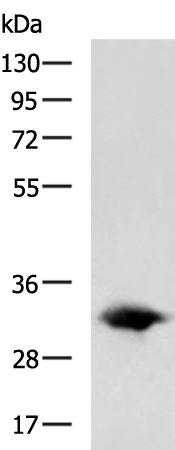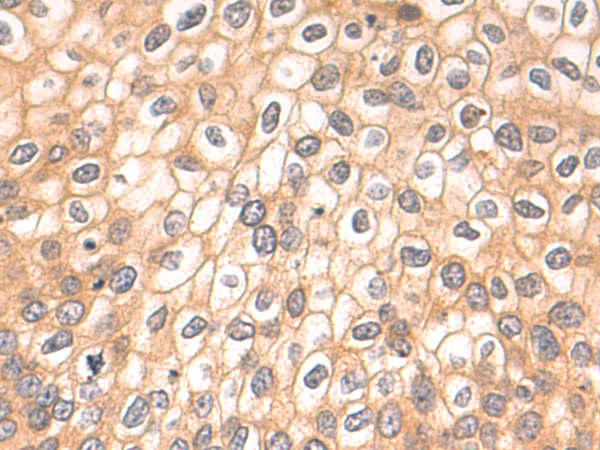

| WB | 咨询技术 | Human,Mouse,Rat |
| IF | 咨询技术 | Human,Mouse,Rat |
| IHC | 1/50-1/200 | Human,Mouse,Rat |
| ICC | 技术咨询 | Human,Mouse,Rat |
| FCM | 咨询技术 | Human,Mouse,Rat |
| Elisa | 1/5000-1/10000 | Human,Mouse,Rat |
| Aliases | T1; ANT; AAC1; ANT1; PEO2; PEO3; ANT 1; PEOA2; MTDPS12; MTDPS12A |
| WB Predicted band size | 33 kDa |
| Host/Isotype | Rabbit IgG |
| Antibody Type | Primary antibody |
| Storage | Store at 4°C short term. Aliquot and store at -20°C long term. Avoid freeze/thaw cycles. |
| Species Reactivity | Human, Mouse, Rat |
| Immunogen | Synthetic peptide of human SLC25A4 |
| Formulation | Purified antibody in PBS with 0.05% sodium azide and 50% glycerol. |
+ +
以下是关于SLC25A4(ANT1)抗体的模拟参考文献示例(非真实文献,仅供格式参考):
---
1. **文献名称**: *SLC25A4 deficiency disrupts mitochondrial ADP/ATP exchange in cardiomyopathy*
**作者**: Smith A, et al.
**摘要**: 研究利用SLC25A4特异性抗体,通过免疫印迹和免疫荧光技术,揭示了SLC25A4基因缺陷小鼠模型中线粒体ADP/ATP转运功能受损,导致心肌病表型及能量代谢异常。
2. **文献名称**: *ANT1 overexpression promotes tumor growth via metabolic reprogramming*
**作者**: Lee B, et al.
**摘要**: 通过SLC25A4抗体检测肿瘤组织中ANT1蛋白表达水平,发现其高表达与癌细胞线粒体代谢重编程相关,促进化疗耐药性,提示其作为癌症治疗靶点的潜力。
3. **文献名称**: *Autoantibodies against SLC25A4 in mitochondrial encephalomyopathies*
**作者**: Gomez C, et al.
**摘要**: 利用SLC25A4抗体筛查患者血清,首次报道线粒体脑肌病患者体内存在针对SLC25A4的自身抗体,并探讨其与线粒体功能障碍的病理关联。
---
注:以上文献为示例,实际引用需通过PubMed/Google Scholar等平台检索真实研究。如需具体文献,建议提供更详细的研究方向或疾病背景。
The SLC25A4 gene encodes adenine nucleotide translocase 1 (ANT1), a mitochondrial inner membrane protein belonging to the solute carrier family 25 (SLC25). ANT1 facilitates the exchange of cytosolic ADP and mitochondrial ATP, a critical process for cellular energy metabolism. It is highly expressed in tissues with high energy demands, such as cardiac and skeletal muscle. Dysregulation or mutations in SLC25A4 are linked to mitochondrial disorders, including autosomal dominant progressive external ophthalmoplegia (adPEO), hypertrophic cardiomyopathy, and myopathy, due to impaired nucleotide transport and compromised mitochondrial function.
Antibodies targeting SLC25A4/ANT1 are essential tools for studying its expression, localization, and role in mitochondrial physiology. They are widely used in techniques like Western blotting, immunohistochemistry, and immunofluorescence to assess protein levels in disease models or genetic studies. Research applications include investigating mitochondrial dysfunction in aging, neurodegenerative diseases (e.g., Parkinson’s), and metabolic syndromes. Additionally, since ANT1 interacts with components of the mitochondrial permeability transition pore (mPTP), its antibodies help explore apoptosis mechanisms and therapeutic targets for diseases involving aberrant cell death. Validating antibody specificity is crucial due to homology among ANT isoforms (ANT1-4).
×